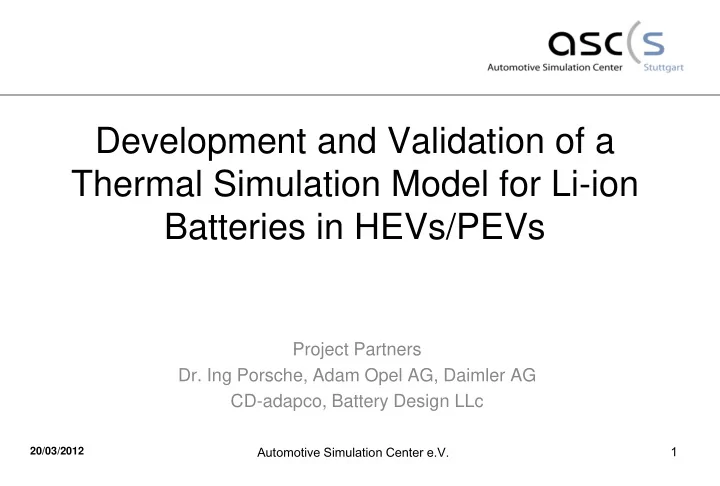

Development and Validation of a Thermal Simulation Model for Li-ion Batteries in HEVs/PEVs Project Partners Dr. Ing Porsche, Adam Opel AG, Daimler AG CD-adapco, Battery Design LLc Automotive Simulation Center e.V. 1 07.10.2011 20/03/2012
Agenda • Description of the Project • Cell Level Modelling • Thermal Modelling considerations • Conclusion Automotive Simulation Center e.V. 2 07.10.2011 20/03/2012
Description of the Project Pictures and data courtesy of Behr Automotive Simulation Center e.V. 3 07.10.2011 20/03/2012
Cell Level Modelling • High Power Pouch Cell • Temp range -10 0 C to +40 0 C • Complete set of tests for 1 cell • 8 cells tested at 1 point – 15C pulses at 30 0 C • Cell Model creation showed 2 effects for this cell – Hysteresis within the OCV curves – Resistance does not follow an Arrhenius law • Learning's for Activity – Current must be zero during rest period – Chose the cell to be tested carefully – OCV measurements are critical – Extension of the RCR model • RCR Tinterp Automotive Simulation Center e.V. 4 07.10.2011 20/03/2012
Cell Level Modelling Hysteresis Model Extension • A real phenomena in cells • Can be reduced by relaxing the cell between measurements Automotive Simulation Center e.V. 5 07.10.2011 20/03/2012
Cell Level Modelling Hysteresis Model Extension Results using the hysteresis model, able to predict discharge and charge correctly Automotive Simulation Center e.V. 6 07.10.2011 20/03/2012
Cell Level Modelling Hysteresis Model Extension – Thermal Modelling Limited literature describing how to account for Hysteresis in thermal models – Model uses average of both curves Where – Therefore total heat generation becomes Automotive Simulation Center e.V. 7 07.10.2011 20/03/2012
Cell Level Modelling Thermal Model Extension • Model used an Arrhenius fit – However cell exhibited 2 activation energies • RCR Model Enhanced – changed to use an interpolation method – Each temperature specific RCR model input – Interpolation as below OCV OCV 2 1 OCV OCV ( T T ) 1 1 T T 2 1 where T 2 >T>T 1 Automotive Simulation Center e.V. 8 07.10.2011 20/03/2012
Cell Level Modelling Thermal Model Extension Automotive Simulation Center e.V. 9 07.10.2011 20/03/2012
Consistency Checks on Whole Pack • Pulse the pack and monitor the cells response – Requires BMS for data – Issues with data capture Automotive Simulation Center e.V. 10 07.10.2011 20/03/2012
Checks on Whole Pack #2 Automotive Simulation Center e.V. 11 07.10.2011 20/03/2012
3D Models 2D Model 3D Model 1D Model • The plane of the current collectors is used to segment the model and produce a distribution of current/potential within the entire cell Automotive Simulation Center e.V. 12 07.10.2011 20/03/2012
Finite Volume Resolution Study • A 2 battery cell model including the conducting parts between was used • This confirmed the appropriate resolution Automotive Simulation Center e.V. 13 07.10.2011 20/03/2012
Thermal Modelling of the Pack • 2 approach's to modelling the coolant channels CPU Cooling Plate T max T min T coolant_exit • 180 field functions added to Seconds Model (C) (C) (C) calculation, not 3D just variables • With Coolant Flow Saving 2 -4 million FV cells 33.23 26.08 31.003 36.8 • Tabular inlet flow rate vs With1-D, Coolant time 33.38 27.49 31.000 12.5 Approx. Automotive Simulation Center e.V. 14 07.10.2011 20/03/2012
Thermal Modelling of the Pack • Effect of the air flow developing in the battery pack and effect of radiation on the cell temperature • The natural convective heat transfer mode affects strongly the thermal heat balance inside the battery and permits a heat exchange between the housing and the border cells Automotive Simulation Center e.V. 15 07.10.2011 20/03/2012
Conclusions • An extensive cell modelling/validation programme has been discussed. • Enhancements to the numerical models delivered. • Items to consider in the complete pack model presented. • The final complete models are running at present. Automotive Simulation Center e.V. 16 07.10.2011 20/03/2012
Recommend
More recommend